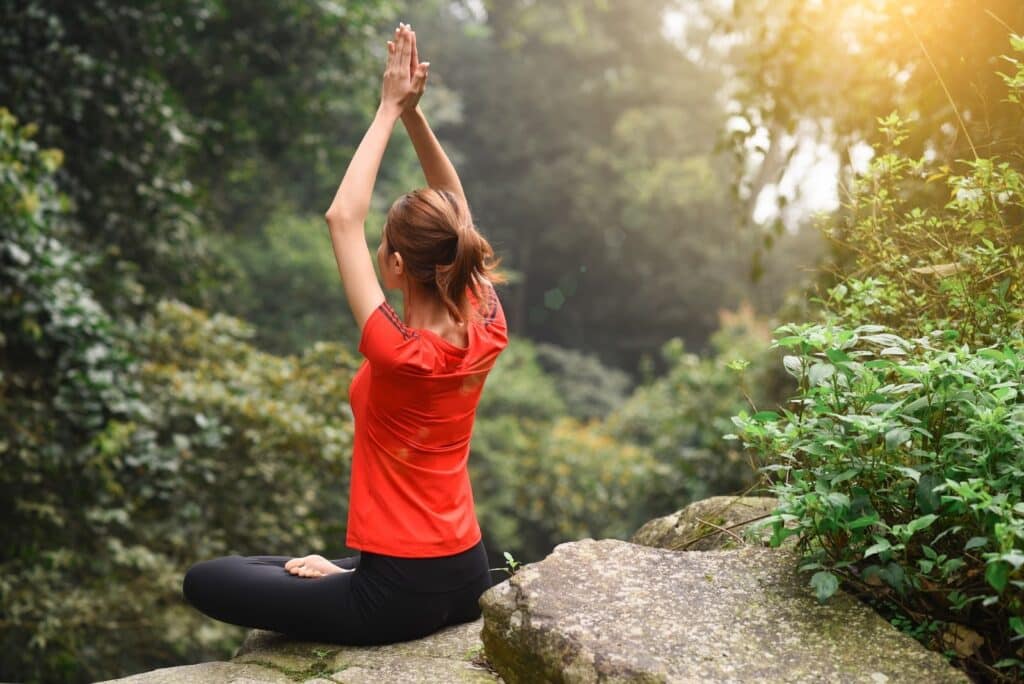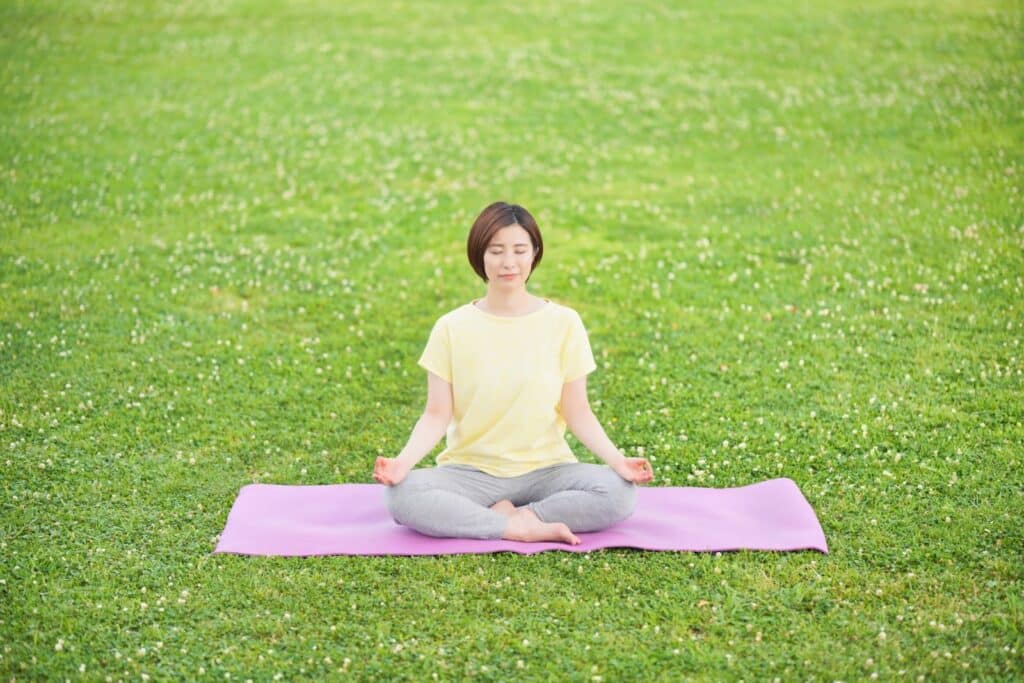Matter Over Mind: How the Body Shapes the Quiet Mind

Quick Summary
In mindfulness, we often hear mind over matter—the belief that willpower can master the body. But modern science and ancient meditation both reveal another truth: sometimes, it’s the body that leads the mind. “Matter over mind” is not a denial of consciousness—it’s a return to the body’s quiet intelligence.
- The Science: Neuroscience shows that breathing, posture, and heartbeat rhythms shape emotional states long before conscious thought.
- The Tradition: From zen to gassho, Eastern meditation trains awareness through body-based practices, not mental force.
- The Practice: Grounding, body scan, and mindful breathing prove that calm arises from sensation, not control.
- The Balance: True mindfulness is not “mind over matter,” but the harmony of both—each reflecting the other’s depth.
Introduction — Turning the Phrase Upside Down
“Mind over matter.”
It’s one of the oldest mantras of human ambition—the idea that thought can conquer flesh, that discipline can silence pain, that the mind rules the body. But what if that hierarchy is backward? Every breath you take changes your brain. Your heartbeat sends constant messages to the cortex, tuning your mood, shaping your awareness. The body is not a servant of the mind; it is a teacher that whispers, through pulse and muscle, how to come home to the present moment. In mindfulness and meditation, we often begin with this quiet rebellion: instead of trying to control our thoughts, we learn to listen to the body—its weight, warmth, and rhythm. What appears to be “matter” begins to reveal a subtle wisdom, one that modern neuroscience is only beginning to understand. To turn mind over matter upside down is not to reject the mind. It is to remember that mind and matter have always been dancing together—and that stillness arises not from domination, but from cooperation.
The Wisdom of Matter — How the Body Guides Mindfulness

For centuries, meditation was viewed as a discipline of the mind. But science keeps returning to a quieter truth: all awareness begins in the body.
Modern neuroscience confirms what Buddhism and yoga intuited long ago—consciousness is embodied. The vagus nerve, linking the heart, lungs, and gut to the brain, forms a living bridge between matter and mind. When slow breathing or chanting activates this nerve, heart rate decreases and the amygdala—the brain’s fear center—settles into calm.
Research from Stanford University reports that slow breathing activates neural circuits that quiet arousal and promote emotional stability, revealing how respiration itself guides the brain toward tranquility.
Other studies show that slow-paced breathing—deliberately reducing respiratory rate—enhances heart rate variability, restores autonomic balance, and reduces stress responses. (Mindfulness Journal – The Effect of Slow-Paced Breathing on Cardiovascular and Emotion Functions)
Posture also acts as a silent teacher. A 2017 study in Applied Psychophysiology and Biofeedback found that sitting upright improves breathing efficiency and psychological stability. Slouched posture correlated with discomfort and negative mood, while an aligned posture deepened breathing and promoted focus and ease.
Touch, warmth, gravity—these are not distractions from meditation; they are meditation itself. Through the material body, we tune the instrument of presence. This is the true meaning of matter over mind: the physical world is not an obstacle to awareness, but the doorway into it.
Ancient Roots — From Buddhism to Embodied Awareness

Long before neuroscience mapped the brain, ancient teachers were mapping the body. In early Buddhist philosophy, all experience was seen as an interplay between form (rūpa) and mind (nāma)—matter and consciousness arising together, never separate. Meditation, then, was not an escape from the body, but a return to it. The Buddha’s own method began with ānāpānasati—mindfulness of breathing. Each breath became both a physical anchor and a mirror for the mind. Later practices like susoku-kan (counting the breath) and zazen (seated meditation) deepened this same recognition: that awareness is cultivated not by thought, but by contact with sensation. In Zen, the phrase mushin—“no mind”—doesn’t mean the absence of thought. It means a state where thought and matter no longer struggle for control. The practitioner becomes fully present in posture, breath, and movement—mind expressed through matter. The same principle echoes in the Gassho tradition, where the act of bringing hands together synchronizes body and consciousness, grounding attention in tangible stillness. These teachings never separated the spiritual from the physical. They understood that enlightenment was not a flight from the body but its refinement—a deep listening to what the body already knows. “Matter over mind” is not new; it is a rediscovery of what every monk, yogi, and mindful walker has always felt: that the body is the first teacher of peace.
Matter Over Mind in Daily Practice

If matter over mind sounds abstract, small acts of awareness can make it real. You don’t need a temple or a mountain retreat—only your body, your breath, and a single moment of noticing.
1. Grounding through the senses
Begin with your feet. Feel the floor’s texture, its firmness, the quiet pull of gravity. In that moment, the mind stops floating. Psychologists call this somatic grounding—a way of re-establishing safety through sensation. It reminds the nervous system that you are, quite literally, supported by the earth.
2. Breathing as dialogue, not control
Instead of trying to “breathe mindfully,” sense how the body is already breathing on its own.
Watch the chest and abdomen gently expand and settle. Let the body lead, without forcing rhythm or depth, and the coherence between breath and brain naturally returns. Science supports this. Research from the Huberman Lab at Stanford University suggests that exhale-focused breathing practices reduce physiological arousal and stimulate the parasympathetic system, allowing the mind to calm naturally. It isn’t control—it’s permission, as if the body had been quietly waiting for the mind to finally rest.
3. Body scan — meditation as listening
A body scan is not a checklist but a conversation. By slowly guiding attention through each region, you give matter a voice. Tension, warmth, tingling—each is a message from the body. As awareness deepens, thought softens—not by suppression, but by listening somewhere else.
4. The gassho approach
In the traditional gesture of gassho, the palms are gently brought together at the chest. This simple act becomes a bridge between matter and spirit. The light pressure of palm against palm heightens tactile awareness and soothes the nervous system. The breath or chant that follows is not commanded by thought, but arises naturally from within the body. The gesture is not a way to create calm, but to remember the stillness that is already there. Through the body, gassho becomes a quiet expression of matter over mind.
Through such small rituals, matter over mind turns from theory into rhythm. The more we honor the body’s signals—fatigue, hunger, heartbeat, breath—the more easily the mind settles. Stillness, it turns out, is not born from effort, but from cooperation.The Balance — Not Mind or Matter, but Both

When science and spirit meet, the question isn’t which side is right. It’s whether we can hear both speaking at once. For centuries, philosophy argued over primacy: idealists claimed that mind creates reality, while materialists insisted that matter gives rise to mind. But mindfulness, in its quiet way, dissolves that argument. It doesn’t take sides; it listens to their conversation. Every moment of awareness is a meeting point. Your thoughts are electrical signals shaped by the chemistry of your breath. Your breath is guided by attention, which is itself shaped by thought. Mind and matter aren’t opponents—they’re partners in an endless loop of cause and effect. This is why deep meditation feels both transcendent and deeply physical. When the mind becomes still, the heartbeat softens; when the heartbeat steadies, the mind becomes still. The two movements are not sequential—they are simultaneous, reflecting each other’s harmony. To live matter over mind is not to reject consciousness, but to recognize that the mind’s finest moments—clarity, compassion, insight— emerge from a body that feels safe and at ease. And to live mind over matter is to honor the body with awareness, intention, and care. The future of mindfulness is not one dominating the other. It is a return to their unity—to the understanding that peace isn’t a victory of mind over matter, but the music they make together.
Conclusion — Listening to the Body’s Quiet Intelligence

Stillness does not come from mastering thought. It comes from remembering that the body is already still. The pulse in your wrist, the rhythm of your breath, the gravity that holds you in place—these are not distractions from awareness. They are awareness, expressed in matter.
When we sit in meditation, the mind may chase ideas of peace. But peace is never an idea. It is the body’s natural language, spoken through warmth, pressure, weight, and breath. When we stop trying to “use” the body to reach the mind, we begin to realize that the body has been guiding us all along. Science describes this as homeostasis, equilibrium, coherence. Tradition calls it harmony, or simply “being.” Either way, the message is the same: the body knows how to rest, if only we listen. To live matter over mind is to notice and respect the body’s quiet wisdom. The mind and body are not ranked; they support each other as partners. When breath and heartbeat settle, the mind naturally becomes calm.
Frequently Asked Questions
FAQ 1: What does “matter over mind” mean in mindfulness?
Answer: It means recognizing that awareness begins in the body, not in the head. Rather than controlling sensations through thought, we allow the body’s natural intelligence—its breath, pulse, and posture—to shape mental calm. This view reverses the traditional “mind over matter” idea by honoring how physical states influence consciousness.
Real Results: Studies from Harvard Medical School show that slow, rhythmic breathing reduces sympathetic nervous system activity, demonstrating how bodily rhythm precedes emotional regulation.
Takeaway: Mindfulness begins where the body speaks first.
FAQ 2: How does the body influence meditation?
Answer: The body constantly sends sensory feedback to the brain through interoception—the perception of internal states. Posture affects blood flow; breath alters heart rate variability; temperature shifts neural tone. These signals define the quality of meditation. When we sit with relaxed alignment, awareness becomes more stable because the body stops signaling danger.
Real Results: Stanford University researchers found that brief breathing regulation enhances prefrontal activity linked to focus and emotional balance.
Takeaway: Meditation deepens when physiology feels safe.
FAQ 3: Is “matter over mind” against the idea of mental control?
Answer: No. It reframes control as cooperation. Mind and matter are partners: attention guides the body, and the body steadies attention. The practice is cyclical, not hierarchical. This perspective helps practitioners release perfectionism and rediscover calm through embodiment rather than discipline.
Real Results: The American Psychological Association (APA) reports that body-oriented mindfulness reduces anxiety more effectively when paired with acceptance rather than control.
Takeaway: Calm grows from cooperation, not dominance.
FAQ 4: What role does the vagus nerve play in “matter over mind”?
Answer: The vagus nerve connects the heart, lungs, and gut to the brain, forming a living bridge between body and mind. Slow breathing and chanting activate this nerve, lowering heart rate and calming emotional arousal.
Real Results: According to ScienceDirect, transcutaneous vagus nerve stimulation (taVNS) improves emotional processing and stress regulation, supporting the vagus nerve’s key role in emotional stability.
Takeaway: The body calms the mind through the vagus nerve’s quiet rhythm.
FAQ 5: How does posture affect mindfulness?
Answer: Posture influences breathing depth, spinal alignment, and circulation. An upright yet relaxed stance stabilizes both oxygen flow and attention. Slouching or rigidity causes discomfort signals that distract the mind. Correct posture harmonizes matter and mind through balanced pressure and gravity.
Real Results: Applied Psychophysiology and Biofeedback (2017) found that upright sitting increases lung capacity by 10–15% and improves calm endurance.
Takeaway: Stillness starts with how the body stands in space.
FAQ 6: Does breathing really shape thought?
Answer: Yes. Breathing patterns directly affect neural oscillations related to focus and emotion. Shallow or rapid breathing sustains anxiety, while slow exhalation synchronizes cortical rhythms with calm. Each breath subtly rewires how attention behaves.
Real Results: Harvard Health Publishing confirms that slow breathing activates parasympathetic responses, reducing cortisol and heart rate within minutes.
Takeaway: Each exhale teaches the mind to soften.
FAQ 7: What ancient teachings support “matter over mind”?
Answer: Early Buddhist texts describe reality as the union of form (rūpa) and mind (nāma). Yogic traditions emphasize prāṇa—the life force moving through breath—as the bridge between matter and awareness. Zen’s mushin (no-mind) expresses harmony between the physical act and mental quiet.
Real Results: Comparative studies in Religions (MDPI, 2021) show that embodied awareness increases compassion and emotional stability across traditions.
Takeaway: The oldest meditations began with the body, not beyond it.
FAQ 8: Is gassho meditation an example of “matter over mind”?
Answer: Yes. By placing the palms together, gassho unites tactile sensation and awareness. The physical gesture regulates breathing and attention simultaneously. It’s a practical model of matter leading mind into focus and gratitude.
Real Results: Practitioners report decreased anxiety and heart rate coherence during tactile-based meditations, similar to data from NCCIH mindfulness research.
Takeaway: Touch anchors the spirit in presence.
FAQ 9: Can “matter over mind” help with stress?
Answer: Absolutely. Stress is largely a physiological cascade—racing heart, tense muscles, fast breath. By addressing these through body-first techniques, we reverse the chain. As the body calms, the brain follows.
Real Results: APA research on somatic mindfulness shows significant drops in cortisol and anxiety scores after 8-week embodied meditation programs.
Takeaway: Relax the body first; the mind will follow.
FAQ 10: How does science view the “mind-body connection”?
Answer: Modern neuroscience views the mind and body as a two-way system. Bodily signals influence the brain’s emotional networks, and in turn, the brain reshapes physiological responses.
Real Results: According to ScienceDirect, neurobiological models of interoception show that sensory awareness is deeply intertwined with emotional experience.
Takeaway: Mind and matter are two directions of the same current.
FAQ 11: What’s the relationship between grounding and mindfulness?
Answer: Grounding means returning awareness to the present moment through physical sensation. Feeling the feet on the ground or the breath in the chest brings stability and safety to the nervous system.
Real Results: According to Frontiers in Neuroscience, interoceptive awareness—the perception of internal sensations—helps regulate emotions and sustain focus.
Takeaway: Feeling the ground brings the mind back from elsewhere.
FAQ 12: Does meditation without body awareness miss something?
Answer: Yes. When the body is ignored, awareness becomes abstract and unfocused. Reconnecting with physical sensations unites thought and experience.
Real Results: According to ScienceDirect, meditations emphasizing interoceptive awareness enhance emotional regulation and attention more effectively than purely cognitive methods.
Takeaway: Awareness grows roots through sensation.
FAQ 13: Can “matter over mind” improve sleep?
Answer: Yes. Slow breathing or body scan meditation before bed activates the parasympathetic system and prepares the body for natural rest.
Real Results: According to Wiley Online Library, short breathing and mindfulness practices significantly reduce stress and improve sleep quality.
Takeaway: Rest begins when the body is allowed to lead.
FAQ 14: How does chanting or sound relate to this idea?
Answer: Chanting uses sound—vibration in matter—to harmonize awareness. The rhythm of sound aligns breath and heartbeat, stabilizing emotional tone.
Real Results: According to ScienceDirect, rhythmic stimuli such as breathing and sound strengthen links between sensory and emotional regulation networks.
Takeaway: Sound is the body’s way of teaching silence.
FAQ 15: Can movement-based meditation express “matter over mind”?
Answer: Yes. Walking meditation, yoga, or tai chi cultivate awareness through movement. Physical rhythm soothes brain activity and deepens focus.
Real Results: According to Oxford Academic, mindful movement practices reduce stress and improve emotional balance.
Takeaway: Stillness can walk; mindfulness can move.
FAQ 16: How does emotion fit into this framework?
Answer: Emotions are bodily events—changes in breath, heartbeat, and chemistry. By observing their physical aspect, we stop being trapped by stories. “Matter over mind” teaches that regulating physiology transforms emotional tone naturally.
Real Results: Emotion journal (APA, 2022) found that body-based awareness reduces emotional reactivity and improves cognitive recovery.
Takeaway: Feelings are messages written in matter.
FAQ 17: Is “matter over mind” compatible with spiritual growth?
Answer: Absolutely. Many traditions see enlightenment as embodied wisdom—awareness expressed through the body rather than apart from it. Respecting the body deepens humility and compassion.
Real Results: According to MDPI, mind-body interventions that emphasize embodiment enhance empathy, emotional stability, and holistic awareness.
Takeaway: The body is the ground where spirit flowers.
FAQ 18: Can beginners practice “matter over mind” easily?
Answer: Yes. It requires no complex philosophy—just attention to what is already present: breath, touch, sound. Beginners often find body-based methods easier than thought-based meditation because feedback is immediate and tangible.
Real Results: NCCIH data show beginner-friendly success in body scan and breathing meditations, with increased adherence over 6 weeks.
Takeaway: Start with the body; the mind will arrive naturally.
FAQ 19: Does technology interfere with this balance?
Answer: Excessive screen use overstimulates visual and cognitive systems, disconnecting awareness from the body. Brief mindfulness or breathing breaks help restore grounding.
Real Results: According to Wiley Online Library, short mindfulness practices throughout the day reduce digital fatigue and workplace stress.
Takeaway: Step out of the screen to step back into the body.
FAQ 20: What is the ultimate lesson of “matter over mind”?
Answer: Peace and stillness don’t come from the mind controlling the body, but from their cooperation. When body and mind listen to each other, balance arises naturally.
Real Results: According to ScienceDirect, integration of sensory and emotional networks supports stability and well-being across mind-body systems.
Takeaway: Peace is the conversation between body and mind, not the conquest of one over the other.
FAQ 21: What should I do when I don’t feel anything during practice?
Answer: Not feeling anything is a feeling. It may be your mind or body’s way of resting. Instead of forcing an experience, allow yourself simply to be there.
Real Results: According to Harvard Health, using a mindful “pause” (e.g., Stop–Breathe–Reflect–Choose) supports self-regulation and helps you respond rather than react.
Takeaway: Stillness often begins not by doing something, but by stopping the need to do.
FAQ 22: Why do I feel no change, even after practicing regularly?
Answer: Change often arrives too quietly to notice. The aim of mindfulness isn’t to become different, but to strengthen your capacity to observe what is.
Real Results: According to Frontiers in Human Neuroscience, long-term mindfulness meditators show objective shifts in resting-state brain network dynamics—evidence that practice can reshape the brain even when subjective change feels subtle.
Takeaway: Growth in stillness happens beneath the surface, even when unseen.
FAQ 23: How can I remember mindfulness in the middle of a busy day?
Answer: Mindfulness isn’t a special event; it’s a moment of remembering. One conscious breath while waiting for the elevator or making coffee is enough.
Real Results: According to Springer (Current Psychology), brief daily micro-breaks during workdays improve recovery and well-being.
According to Harvard Health, even short, regular mindfulness moments can provide respite and support focus.
Takeaway: Calm isn’t something to schedule—it’s something to notice.
Related Articles
- Frontiers in Psychology – Embodied Awareness and Emotional Regulation
Peer-reviewed research explaining how body-based mindfulness reshapes emotional processing and enhances resilience. - Stanford Medicine – How Breathing Shapes the Brain
Recent findings showing that controlled breathing patterns directly modulate attention and anxiety circuits. - NCCIH – Mind and Body Practices for Health
U.S. National Center for Complementary and Integrative Health overview of body-focused meditation and stress reduction evidence. - Mindfulness Meditation and the Brain: The Science Behind Its Benefits
An accessible guide explaining how mindfulness meditation influences the brain, helping to regulate stress, emotion, and awareness. - Yoga and Meditation: A Path to Relaxation, Focus, and Inner Peace
Explores the historical and practical relationship between yoga and meditation, outlining key types, techniques, and their shared benefits.
